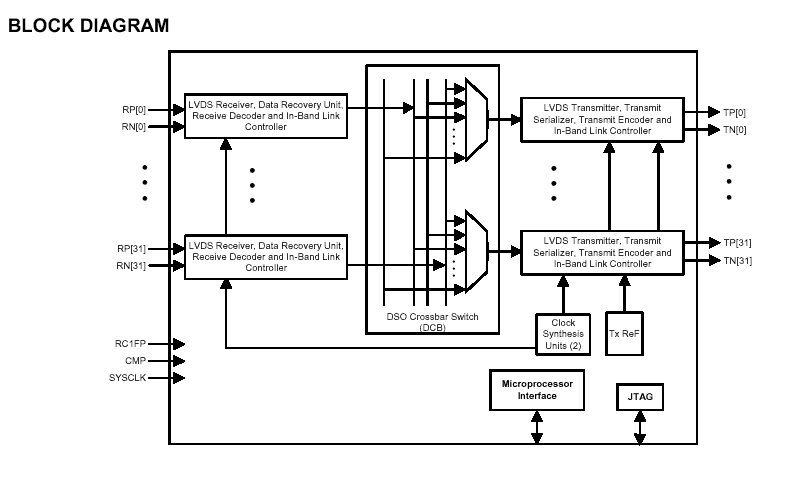Features: The Narrowband Switch Element 20G (NSE-20G):
• Implements a Scaleable Bandwidth Interconnect (SBI™) DS0 granularity Space switch.
• Implements a SONET/SDH VT1.5/VT2/TU11/TU12 granularity Space switch for the serial 77.6 MHz LVDS TelecomBus.
• With the allied SBS or SBS-lite device, implements a DS0 granularity Memory-Space- emory switch.
• Supports 32 STS-12 equivalent serial ports via 777.6 MHz, 8B/10B encoded LVDS links each port can be either Serial TelecomBus or Serial SBI336S)
• When configured for SBI mode, switches DS0 or N*DS0 for all T1 and E1 tributaries and ggregate columns for switching T1, E1, TVT1.5, TVT2, DS3 and E3 tributaries.
• When configured for the serial 777.6 MHz TelecomBus interface, switches any SONET/SDH irtual tributary or tributary unit up to STS-1.
• Supports switching of arbitrary non-standard octet aggregates.
• Supports unicast, multicast, and broadcast for all switching modes.
• Provides 20 Gbit/s (258,048 DS0s, 10,752 T1s/VT1.5s, 8,064 E1s/VT2s, 384 DS3s/E3s) witching.
• Works with SBS devices that support up to four 19.44 MHz SBI buses or one 77.76 MHz BI336 bus that communicates with PMC-Sierra's SBI device family. Alternatively, the SBS nd SBS-lite devices support up to four 19.44 MHz STS-3 TelecomBuses or one 77.76 MHz TS-12 TelecomBus for connection with PMC-Sierra's SPECTRA™ family of devices.
• Can be combined in applications with PMC-Sierra's CHESS™ Set devices (PM5374 TSE nd PM5307 TBS).
• Supports a microprocessor interface which is used to configure/control the NSE, to make S0-granularity switch settings.
• Supports clean error checked 8 Mbit/s full-duplex, in-band communications channels from he NSE's attached microprocessor to the attached microprocessors of each of the 32 attached BS336S devices. This channel is used to initialize and control the SBSs, or other such evices, and to implement call-establishment set-up changes.
• Supports JTAG for all non-LVDS signals.
• Requires dual power supplies at 1.8 V and 3.3 V.
• Packaged as a 480 ball UBGA.
• In conjunction with the SBS or SBS-lite, supports "1+1" and "1:N" fabric redundancy.
ApplicationThe PM8620 Narrowband Switch Element (NSE) supports a variety of flexible Layer 1 and Layer
2 architectures in combination with the following PMC-Sierra devices:
• PM8610 SBS and PM8611 SBS-lite (SBI Serializer and Memory switching stage)
• SBI bus devices (PM8315 TEMUX™/PM5365 TEMAP, FREEDM™ devices, S/UNI®-IMA evices, AAL1gator™ devices, and other future devices)
• CHESS chip set devices (PM5374 TSE, PM5307 TBS, PM5315 SPECTRA™-2488, and M7390 S/UNI®-MACH48)
These architectures include:
• T1/E1 SONET Add/Drop Multiplexers (ADMs)
• TDM ASAP applications
• PHY cards with DS0 (and above) level switching
• PSTN replacement switching cores, as part of any-service-any-port applications
• Voice Gateways
Pinout Description
DescriptionThe PM8620 NSE-20G is a monolithic CMOS integrated circuit packaged in a 480 ball UBGA hat performs DS0 and above granularity space switching on 32 SBI336 streams carried as serial BI336S in 8B/10B coding over LVDS at 777.6 Mbit/s. The NSE-20G also performs VT1.5/VT2 nd above granularity switching on 32 STS-12/STM-4 SONET/SDH streams, carried as Serial elecomBus signals in 8B/10B coding over LVDS at 777.6 Mbit/s.
The NSE-20G is typically used with up to 32 PM8610 SBS or PM8611 SBS-lite devices to rovide Memory-Space-Memory switching systems. As each SBS supports either four SBI buses t 19.44 MHz or one SBI336 bus at 77.76 MHz, the overall system supports any mixture of SBI nd SBI336 byte serial buses, ranging from 128 19.44 MHz SBI buses to 32 SBI336 77.76 MHz uses that do not exceed an aggregate bandwidth of STS-384, or about 20 Gbit/s. In TelecomBus ode, the SBS devices support the same range of flexibility for 128 19.44 MHz and 32 77.76 Hz TelecomBuses at VT1.5/VT2 granularity
Central to the NSE-20G is a 32 x 32 cross bar switch. At every clock cycle, the cross bar witches a byte of data with control signals from each input port to an output port. The byte of ata may be a DS0 channel from a T1/E1 or may be one byte of a column comprising a T1, E1, S3, E3, VT1.5, VT2 or STS-1.
In order for switching to take place all input and output streams must be synchronized. PM8620 is one via the RC1FP input signal. When switching T1s, E1s, VTs and other higher order units only BI336 multiframe alignment is required. The same applies for TelecomBus mode where only rame alignment is required.
An in-band control link over the serial LVDS interface allows the NSE-20G to communicate with he microprocessors attached to the SBS, SBS-lite or other serial SBI336S devices. The effective andwidth of each inband link to each device is 8 Mbit/s. The inband link of PM8620 provides error etection on 32-byte user messages and some near realtime control signals between devices.
Using the near realtime control signals, the NSE-20G is able to synchronize page switching, ndicate switchover between working or protected links, and exchange three user of PM8620 defined signals software) and 8 Auxilliary signals (software). The user of PM8620 and auxilliary signals can be used to ndicates interrupts or initiate handshaking between the end point microprocessors. The message ormat is left to the user of PM8620. The only constraint is that each message is a maximum of 2 bytes long.

 PM8620 Data Sheet
PM8620 Data Sheet







